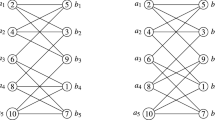Abstract
The amalgamation technique has been introduced for groups by Higman et al. [8] and Goldschmidt [7] and developed on geometries by Kegel and Schleiermacher [9]. We define a “graph amalgam” to point out a different approach to certain classes of cubic bipartite graphs. Furthermore, we find relations between graph amalgams, 3-bridges and star-products of cubic bipartite graphs.
Similar content being viewed by others
References
J. Di Paola and H. Gropp, Symmetric configurations without blocking sets, Mitteilungen Math. Sem. Giessen, Vol. 201 (1991) pp. 49–54.
H. L. Dorwart and B. Gruenbaum, Are these figures oximora?, Math. Magazine, Vol. 65, No. 3 (1992) pp. 158–169.
H. Gropp, Blocking set free configurations and their relations to digraphs and hypergraphs, Discrete Math., Vol. 165/166 (1997) pp. 359–370.
M. Funk, B. Jackson, D. Labbate and J. Sheehan, Det-extremal cubic bipartite graphs, J. Graph Theory, Vol. 44, No. 1 (2003) pp. 50–64.
M. Funk, B. Jackson, D. Labbate and J. Sheehan, 2–Factor hamiltonian graphs, Dedicated to Crispin St. J. A. Nash-Williams, J. Combin. Theory Ser. B, Vol. 87, No. 1 (2003) pp. 138–144.
M. Funk and D. Labbate, On minimally one-factorable r-regular bipartite graphs, Discrete Math., Vol. 216 (2000) pp. 121–137.
D. Goldschmidt, Automorphism of trivalent graphs, Ann. of Math. (2), Vol. 111, No. 2 (1980) pp. 377–406.
G. Higman, B. H. Neumann and H. Neumann, Embedding theorems for groups, J. London Math. Soc., Vol. 24 (1949) pp. 247–254.
O. H. Kegel and A. Schleiermacher, Amalgams and embeddings of projective planes, Geometriae Dedicata, Vol. 2 (1973) pp. 379–395.
D. Labbate, On determinants and permanents of minimally 1–factorable cubic bipartite graphs, Note Mat., Vol. 20, No. 1 (2000/01) pp. 37–42.
D. Labbate, On 3–cut reductions of minimally 1–factorable cubic bigraphs, Discrete Math., Vol. 231 (2001) pp. 303–310.
D. Labbate, Characterizing minimally 1–factorable r-regular bipartite graphs, Discrete Math., Vol. 248, No. 1–3 (2002) pp. 109–123.
W. McCuaig, Even dicycles, J. Graph Theory, Vol. 35 (2000) pp. 46–68.
Serre, Jean-Pierre Arbres, amalgames, SL2. Astèrisque, No. 46. Société Mathématique de France, Paris (1977).
C. Thomassen, Sign-nonsingular matrices and even cycles in directed graphs, Linear Algebra Appl., Vol. 75 (1986) pp. 27–41.
Author information
Authors and Affiliations
Rights and permissions
About this article
Cite this article
Labbate, D. Amalgams of Cubic Bipartite Graphs. Designs, Codes and Cryptography 32, 267–275 (2004). https://doi.org/10.1023/B:DESI.0000029229.06512.83
Issue Date:
DOI: https://doi.org/10.1023/B:DESI.0000029229.06512.83




